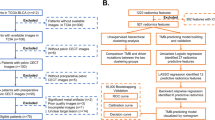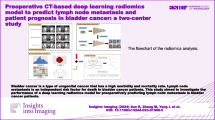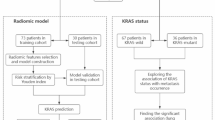Abstract
Objectives
To develop an MRI radiomic nomogram capable of identifying muscle invasive bladder cancer (MIBC) patients with high-risk molecular characteristics related to poor 2-year disease-free survival (DFS).
Methods
We performed a retrospective analysis of DNA sequencing data, prognostic information, and radiomics features from 91 MIBC patients at stages T2-T4aN0M0 without history of immunotherapy. To identify risk stratification, we employed Cox regression based on TP53 mutation status and tumor mutational burden (TMB) level. Radiomics signatures were selected using the least absolute shrinkage and selection operator (LASSO) to construct a nomogram based on logistic regression for predicting the stratification in the training cohort. The predictive performance of the nomogram was assessed in the testing cohort using receiver operator curve (ROC), Hosmer–Lemeshow (HL) test, clinical impact curve (CIC), and decision curve analysis (DCA).
Results
Among 91 participants, the mean TMB value was 3.3 mut/Mb, with 60 participants having TP53 mutations. Patients with TP53 mutations and a below-average TMB value were identified as high risk and had a significantly poor 2-year DFS (hazard ratio = 4.36, 95% CI 1.82–10.44, P < 0.001). LASSO identified five radiomics signatures that correlated with the risk stratification. In the testing cohort, the nomogram achieved an area under the ROC curve of 0.909 (95% CI 0.789–0.991) and an accuracy of 0.889 (95% CI 0.708–0.977).
Conclusion
The molecular risk stratification based on TP53 mutation status combined with TMB level is strongly associated with DFS in MIBC. Radiomics signatures can effectively predict this stratification and provide valuable information to clinical decision-making.
Graphical abstract






Similar content being viewed by others
References
Patel Vaibhav G, William K Oh and Matthew D Galsky. Treatment of muscle-invasive and advanced bladder cancer in 2020. CA: a cancer journal for clinicians, 2020. 70(5): p. 404-423.
Zhang Lu, Xiaoyang Li, Li Yang, Ying Tang, Junting Guo, Ding Li, Shuo Li, Yan Li, Le Wang, and Ying Lei. Multi‐Sequence and Multi‐Regional MRI‐Based Radiomics Nomogram for the Preoperative Assessment of Muscle Invasion in Bladder Cancer. Journal of Magnetic Resonance Imaging.
NCCN Guidelines Version 2.2022 Bladder Cancer. 2022: National Comprehensive Cancer Network Web site. https://www.nccn.org/professionals/physician_gls/pdf/bladder.pdf.
Smith Steven Christopher, Alexander Spyridon Baras, Garrett Dancik, Yuanbin Ru, Kuan-Fu Ding, Christopher A Moskaluk, Yves Fradet, Jan Lehmann, Michael Stöckle, and Arndt Hartmann. A 20-gene model for molecular nodal staging of bladder cancer: development and prospective assessment. The lancet oncology, 2011. 12(2): p. 137-143.
Stein John P, Gary Lieskovsky, Richard Cote, Susan Groshen, An-Chen Feng, Stuart Boyd, Eila Skinner, Bernard Bochner, Duriayai Thangathurai, and Maged Mikhail. Radical cystectomy in the treatment of invasive bladder cancer: long-term results in 1,054 patients. Journal of clinical oncology, 2001. 19(3): p. 666-675.
Yafi Faysal A, Armen G Aprikian, Joseph L Chin, Yves Fradet, Jonathan Izawa, Eric Estey, Adrian Fairey, Ricardo Rendon, Ilias Cagiannos, and Louis Lacombe. Contemporary outcomes of 2287 patients with bladder cancer who were treated with radical cystectomy: a Canadian multicentre experience. BJU international, 2011. 108(4): p. 539-545.
Kamoun Aurélie, Aurélien de Reyniès, Yves Allory, Gottfrid Sjödahl, A Gordon Robertson, Roland Seiler, Katherine A Hoadley, Clarice S Groeneveld, Hikmat Al-Ahmadie, and Woonyoung Choi. A consensus molecular classification of muscle-invasive bladder cancer. European urology, 2020. 77(4): p. 420-433.
Gurung Pratik MS, Abhi Veerakumarasivam, Magali Williamson, Nicholas Counsell, James Douglas, Wei Shen Tan, Andrew Feber, Simon J Crabb, Susan C Short, and Alex Freeman. Loss of expression of the tumour suppressor gene AIMP3 predicts survival following radiotherapy in muscle‐invasive bladder cancer. International Journal of Cancer, 2015. 136(3): p. 709-720.
Choi Woonyoung, Sima Porten, Seungchan Kim, Daniel Willis, Elizabeth R Plimack, Jean Hoffman-Censits, Beat Roth, Tiewei Cheng, Mai Tran, and I-Ling Lee. Identification of distinct basal and luminal subtypes of muscle-invasive bladder cancer with different sensitivities to frontline chemotherapy. Cancer cell, 2014. 25(2): p. 152-165.
Sabapathy Kanaga and David P Lane. Therapeutic targeting of p53: all mutants are equal, but some mutants are more equal than others. Nature reviews Clinical oncology, 2018. 15(1): p. 13-30.
Li Hongyan, Huayi Lu, Wanli Cui, Yufan Huang, and Xuefei Jin. A TP53-based immune prognostic model for muscle-invasive bladder cancer. Aging (Albany NY), 2021. 13(2): p. 1929.
Finlay Cathy A, Philip W Hinds and Arnold J Levine. The p53 proto-oncogene can act as a suppressor of transformation. Cell, 1989. 57(7): p. 1083-1093.
Lawson Andrew RJ, Federico Abascal, Tim HH Coorens, Yvette Hooks, Laura O’Neill, Calli Latimer, Keiran Raine, Mathijs A Sanders, Anne Y Warren, and Krishnaa TA Mahbubani. Extensive heterogeneity in somatic mutation and selection in the human bladder. Science, 2020. 370(6512): p. 75-82.
Tran L, JF Xiao, N Agarwal, JE Duex, and D Theodorescu. Advances in bladder cancer biology and therapy. Nature reviews. Cancer, 2021. 21(2): p. 104-121.
Jardim Denis L, Aaron Goodman, Debora de Melo Gagliato, and Razelle Kurzrock. The challenges of tumor mutational burden as an immunotherapy biomarker. Cancer cell, 2021. 39(2): p. 154-173.
Bagaev Alexander, Nikita Kotlov, Krystle Nomie, Viktor Svekolkin, Azamat Gafurov, Olga Isaeva, Nikita Osokin, Ivan Kozlov, Felix Frenkel, and Olga Gancharova. Conserved pan-cancer microenvironment subtypes predict response to immunotherapy. Cancer cell, 2021. 39(6): p. 845-865. e7.
Zhao Zhenyu, Boxue He, Qidong Cai, Pengfei Zhang, Xiong Peng, Yuqian Zhang, Hui Xie, and Xiang Wang. Combination of tumor mutation burden and immune infiltrates for the prognosis of lung adenocarcinoma. International Immunopharmacology, 2021. 98: p. 107807.
Jiang Xianjie, Jie Wang, Xiangying Deng, Fang Xiong, Junshang Ge, Bo Xiang, Xu Wu, Jian Ma, Ming Zhou, and Xiaoling Li. Role of the tumor microenvironment in PD-L1/PD-1-mediated tumor immune escape. Molecular cancer, 2019. 18(1): p. 1-17.
Xu Yijia, Han Zeng, Kaifeng Jin, Zhaopei Liu, Yu Zhu, Le Xu, Zewei Wang, Yuan Chang, and Jiejie Xu. Immunosuppressive tumor-associated macrophages expressing interlukin-10 conferred poor prognosis and therapeutic vulnerability in patients with muscle-invasive bladder cancer. Journal for Immunotherapy of Cancer, 2022. 10(3).
Hoffman-Censits Jean, Woonyoung Choi, Sumanta Pal, Edouard Trabulsi, William Kevin Kelly, Noah M Hahn, David McConkey, Eva Comperat, Andres Matoso, and Oliver Cussenot. Urothelial cancers with small cell variant histology have confirmed high tumor mutational burden, frequent TP53 and RB mutations, and a unique gene expression profile. European Urology Oncology, 2021. 4(2): p. 297-300.
Jiang Minlin, Keyi Jia, Lei Wang, Wei Li, Bin Chen, Yu Liu, Hao Wang, Sha Zhao, Yayi He, and Caicun Zhou. Alterations of DNA damage response pathway: Biomarker and therapeutic strategy for cancer immunotherapy. Acta Pharmaceutica Sinica B, 2021. 11(10): p. 2983-2994.
Lambin P, E Rios-Velazquez, R Leijenaar, S Carvalho, RG van Stiphout, P Granton, CM Zegers, R Gillies, R Boellard, A Dekker, and HJ Aerts. Radiomics: extracting more information from medical images using advanced feature analysis. European journal of cancer (Oxford, England : 1990), 2012. 48(4): p. 441-6.
Choi YS, S Bae, JH Chang, SG Kang, SH Kim, J Kim, TH Rim, SH Choi, R Jain, and SK Lee. Fully automated hybrid approach to predict the IDH mutation status of gliomas via deep learning and radiomics. Neuro-oncology, 2021. 23(2): p. 304-313.
Avesani G, HE Tran, G Cammarata, F Botta, S Raimondi, L Russo, S Persiani, M Bonatti, T Tagliaferri, M Dolciami, V Celli, L Boldrini, J Lenkowicz, P Pricolo, F Tomao, SMR Rizzo, N Colombo, L Manganaro, A Fagotti, G Scambia, B Gui, and R Manfredi. CT-Based Radiomics and Deep Learning for BRCA Mutation and Progression-Free Survival Prediction in Ovarian Cancer Using a Multicentric Dataset. Cancers, 2022. 14(11).
Sun K, H Zhu, W Chai, and F Yan. TP53 Mutation Estimation Based on MRI Radiomics Analysis for Breast Cancer. Journal of magnetic resonance imaging : JMRI, 2022.
İnce Okan, Hülya Yıldız, Tanju Kisbet, Şükrü Mehmet Ertürk, and Hakan Önder. Classification of retinoblastoma-1 gene mutation with machine learning-based models in bladder cancer. Heliyon, 2022. 8(4): p. e09311.
Zwanenburg Alex, Martin Vallières, Mahmoud A Abdalah, Hugo JWL Aerts, Vincent Andrearczyk, Aditya Apte, Saeed Ashrafinia, Spyridon Bakas, Roelof J Beukinga, and Ronald Boellaard. The image biomarker standardization initiative: standardized quantitative radiomics for high-throughput image-based phenotyping. Radiology, 2020. 295(2): p. 328-338.
Chawla Nitesh V, Kevin W Bowyer, Lawrence O Hall, and W Philip Kegelmeyer. SMOTE: synthetic minority over-sampling technique. Journal of artificial intelligence research, 2002. 16: p. 321-357.
Liu Hua-Ping, Wei Jia, Gaohaer Kadeerhan, Bo Xue, Wenmin Guo, Lu Niu, Xiaoliang Wang, Xiaolin Wu, Haitao Li, and Jun Tian. Individualized prognosis stratification in muscle invasive bladder cancer: A pairwise TP53-derived transcriptome signature. Translational Oncology, 2023. 29: p. 101629.
Yang Chen, Xiaowen Huang, Yan Li, Junfei Chen, Yuanyuan Lv, and Shixue Dai. Prognosis and personalized treatment prediction in TP53-mutant hepatocellular carcinoma: an in silico strategy towards precision oncology. Briefings in bioinformatics, 2021. 22(3): p. bbaa164.
Lillemoe Heather A, Guillaume Passot, Yoshikuni Kawaguchi, Mario DeBellis, Olivier Glehen, Yun Shin Chun, Ching-Wei D Tzeng, Thomas A Aloia, Jonathan Lopez, and Jean-Nicolas Vauthey. RAS/TP53 co-mutation is associated with worse survival after concurrent resection of colorectal liver metastases and extrahepatic disease. Annals of surgery, 2022. 276(2): p. 357-362.
Xu Feng, Haoyu Lin, Pei He, Lulu He, Jiexin Chen, Ling Lin, and Yongsong Chen. A TP53-associated gene signature for prediction of prognosis and therapeutic responses in lung squamous cell carcinoma. Oncoimmunology, 2020. 9(1): p. 1731943.
Wang Xinyi, Jinzhong Duanmu, Xiaorui Fu, Taiyuan Li, and Qunguang Jiang. Analyzing and validating the prognostic value and mechanism of colon cancer immune microenvironment. Journal of Translational Medicine, 2020. 18(1): p. 1-14.
Li Ziyu, Yongning Jia, Honglin Zhu, Xiaofang Xing, Fei Pang, Fei Shan, Shuangxi Li, Danhua Wang, Fangping Zhao, and Tonghui Ma. Tumor mutation burden is correlated with response and prognosis in microsatellite-stable (MSS) gastric cancer patients undergoing neoadjuvant chemotherapy. Gastric Cancer, 2021. 24(6): p. 1342-1354.
Wei Cheng, Minzhe Li, Shaofeng Lin, and Jun Xiao. Characterization of Tumor Mutation Burden-Based Gene Signature and Molecular Subtypes to Assist Precision Treatment in Gastric Cancer. BioMed Research International, 2022. 2022.
Yu Jie, QianYun Zhang, MengChuan Wang, SiJia Liang, HongYun Huang, Lang Xie, ChunHui Cui, and JinLong Yu. Comprehensive analysis of tumor mutation burden and immune microenvironment in gastric cancer. Bioscience Reports, 2021. 41(2): p. BSR20203336.
Nd James. Radiotherapy with or without chemotherapy in muscle-invasive bladder cancer. N. Engl. J. Med., 2012. 366: p. 1477-1488.
Yang Xiao, Baorui Yuan, Yudong Zhang, Juntao Zhuang, Lingkai Cai, Qikai Wu, Qiang Cao, Pengchao Li, Qiang Lu, and Xueying Sun. Quantitative multiparametric MRI as a promising tool for the assessment of early response to neoadjuvant chemotherapy in bladder cancer. European Journal of Radiology, 2022. 157: p. 110587.
Dankers Frank JWM, Alberto Traverso, Leonard Wee, and Sander MJ van Kuijk. Prediction modeling methodology. Fundamentals of clinical data science, 2019: p. 101-120.
Lo Gullo Roberto, Isaac Daimiel, Carolina Rossi Saccarelli, Almir Bitencourt, Peter Gibbs, Michael J Fox, Sunitha B Thakur, Danny F Martinez, Maxine S Jochelson, and Elizabeth A Morris. Improved characterization of sub-centimeter enhancing breast masses on MRI with radiomics and machine learning in BRCA mutation carriers. European radiology, 2020. 30(12): p. 6721-6731.
Funding
This study was supported by the National Natural Science Foundation of China (Grant No. 81971592); the Four “Batches” Innovation Project of Invigorating Medical through Science and Technology of Shanxi Province (2023XM011); the China International Medical Foundation of China (z-2014-07-2301).
Author information
Authors and Affiliations
Corresponding author
Additional information
Publisher's Note
Springer Nature remains neutral with regard to jurisdictional claims in published maps and institutional affiliations.
Supplementary Information
Below is the link to the electronic supplementary material.
Rights and permissions
Springer Nature or its licensor (e.g. a society or other partner) holds exclusive rights to this article under a publishing agreement with the author(s) or other rightsholder(s); author self-archiving of the accepted manuscript version of this article is solely governed by the terms of such publishing agreement and applicable law.
About this article
Cite this article
Fan, Zc., Zhang, L., Yang, Gq. et al. MRI radiomics for predicting poor disease-free survival in muscle invasive bladder cancer: the results of the retrospective cohort study. Abdom Radiol 49, 151–162 (2024). https://doi.org/10.1007/s00261-023-04028-3
Received:
Revised:
Accepted:
Published:
Issue Date:
DOI: https://doi.org/10.1007/s00261-023-04028-3




